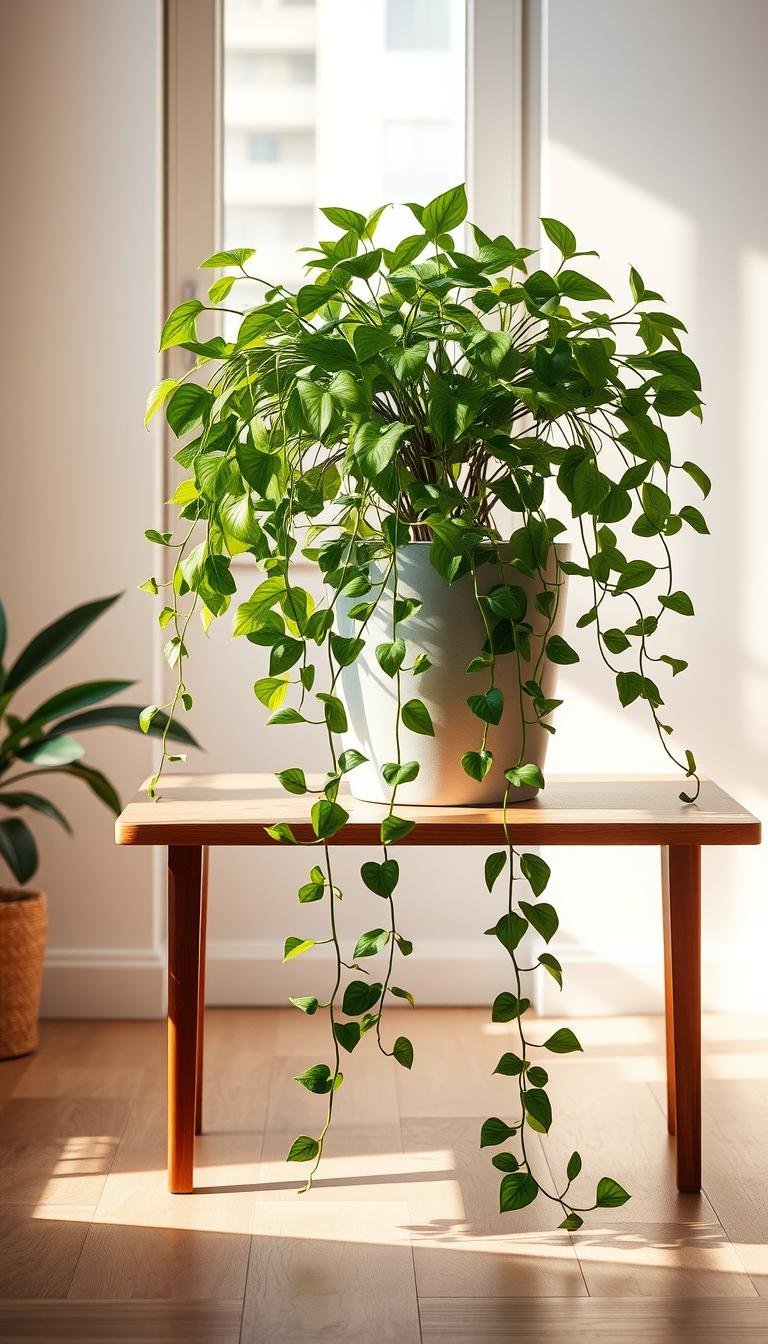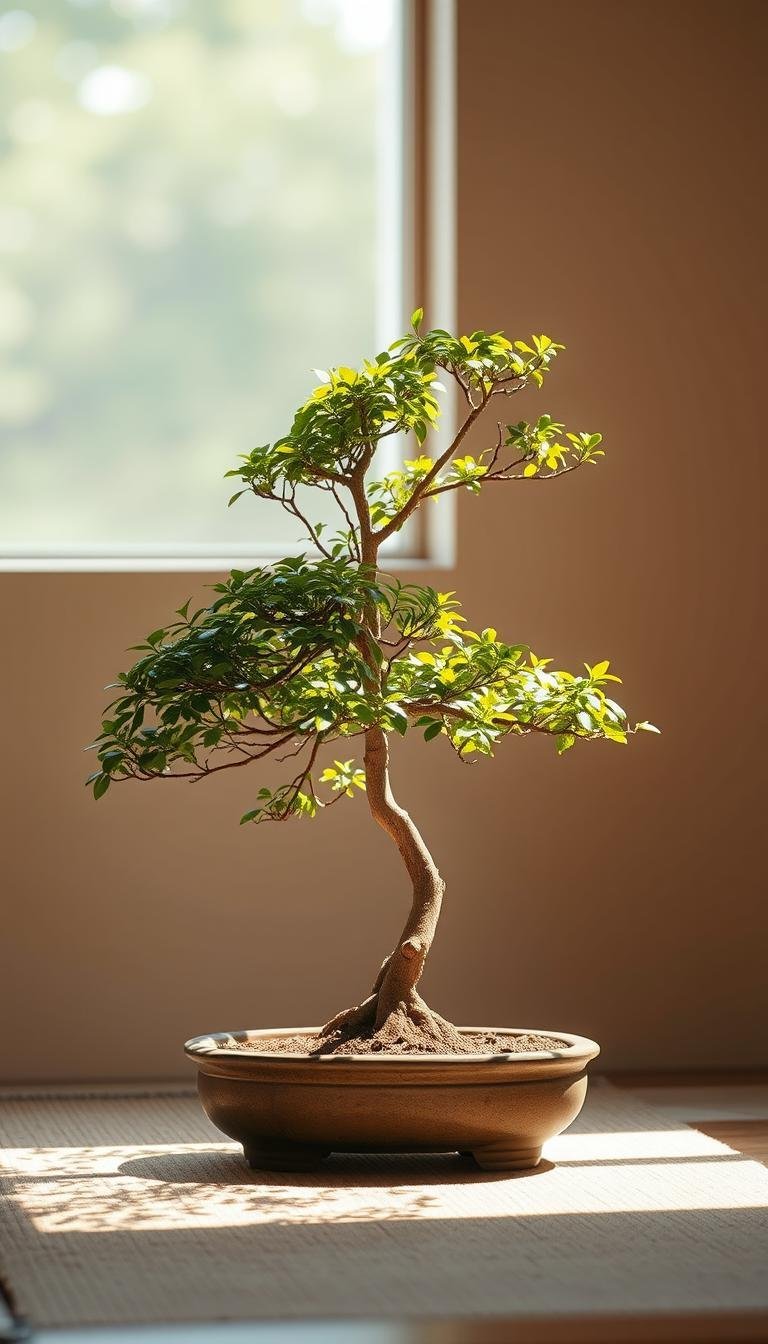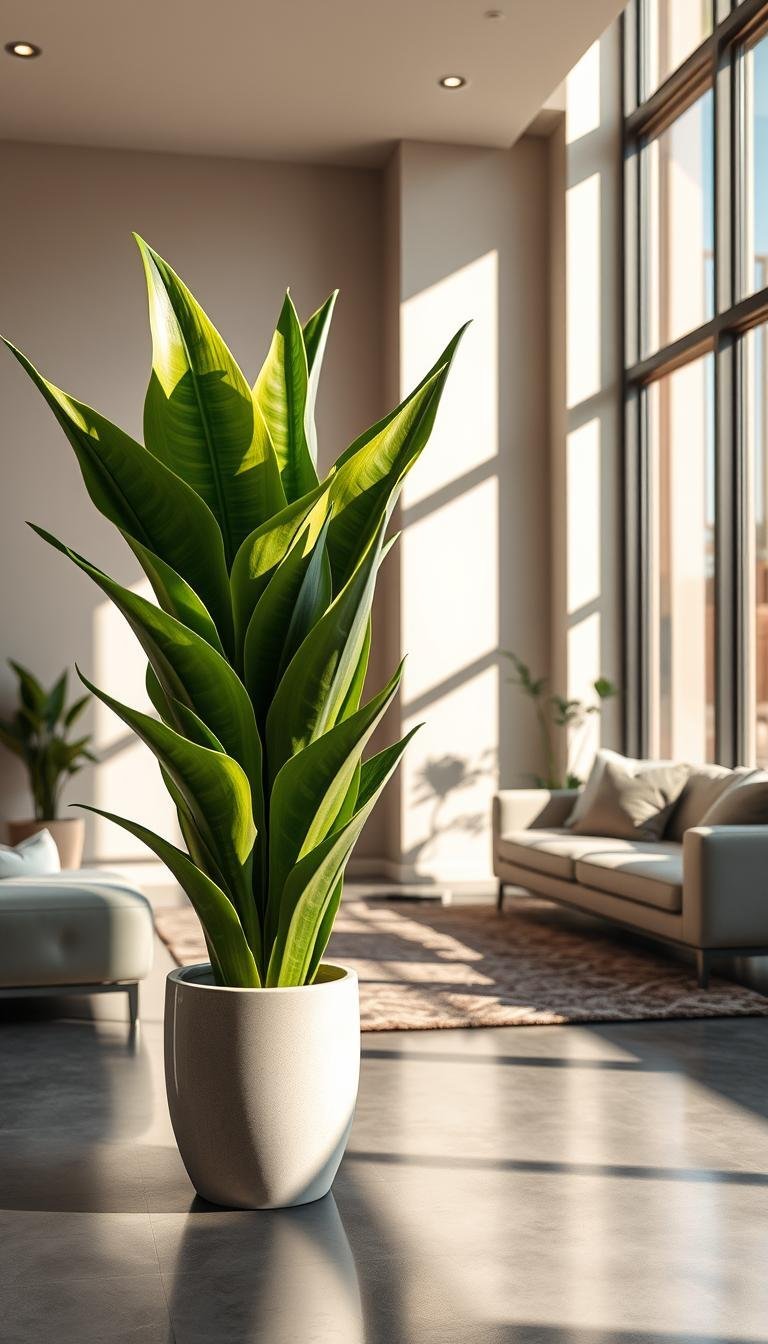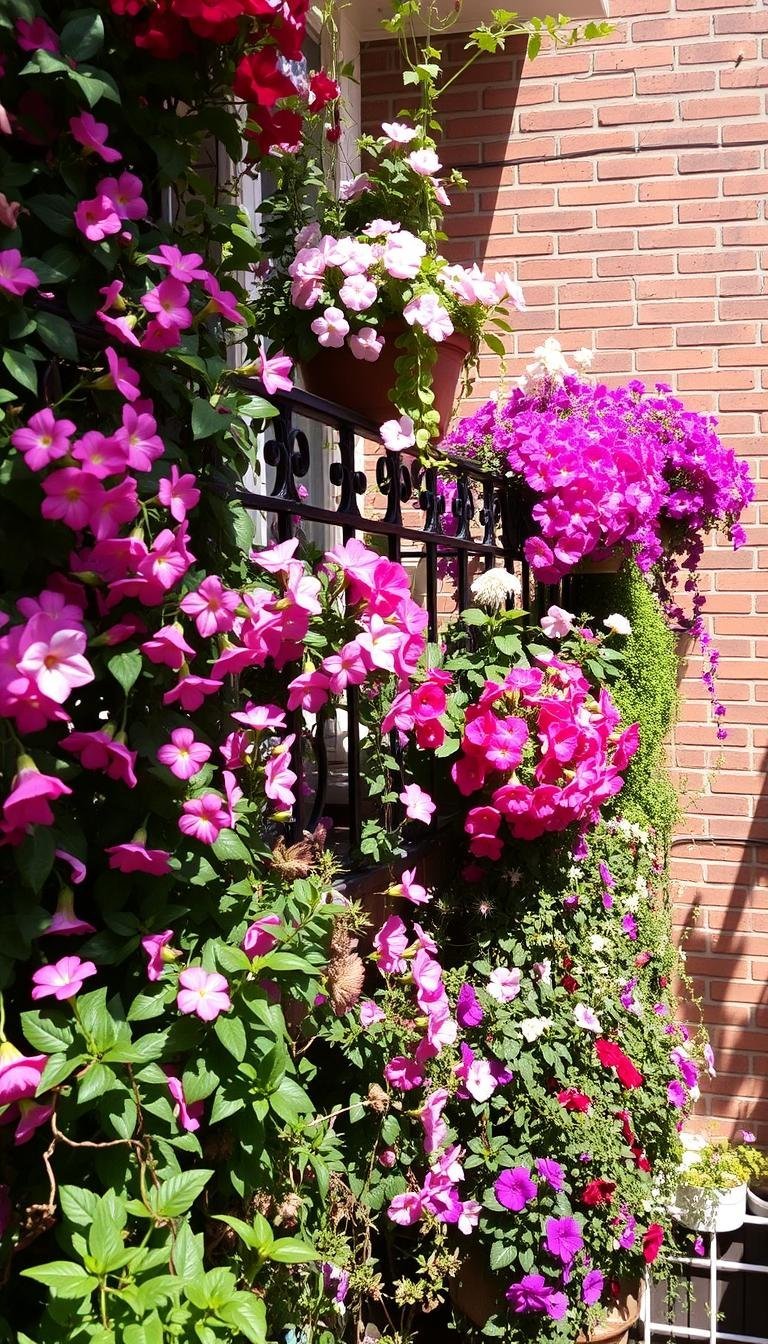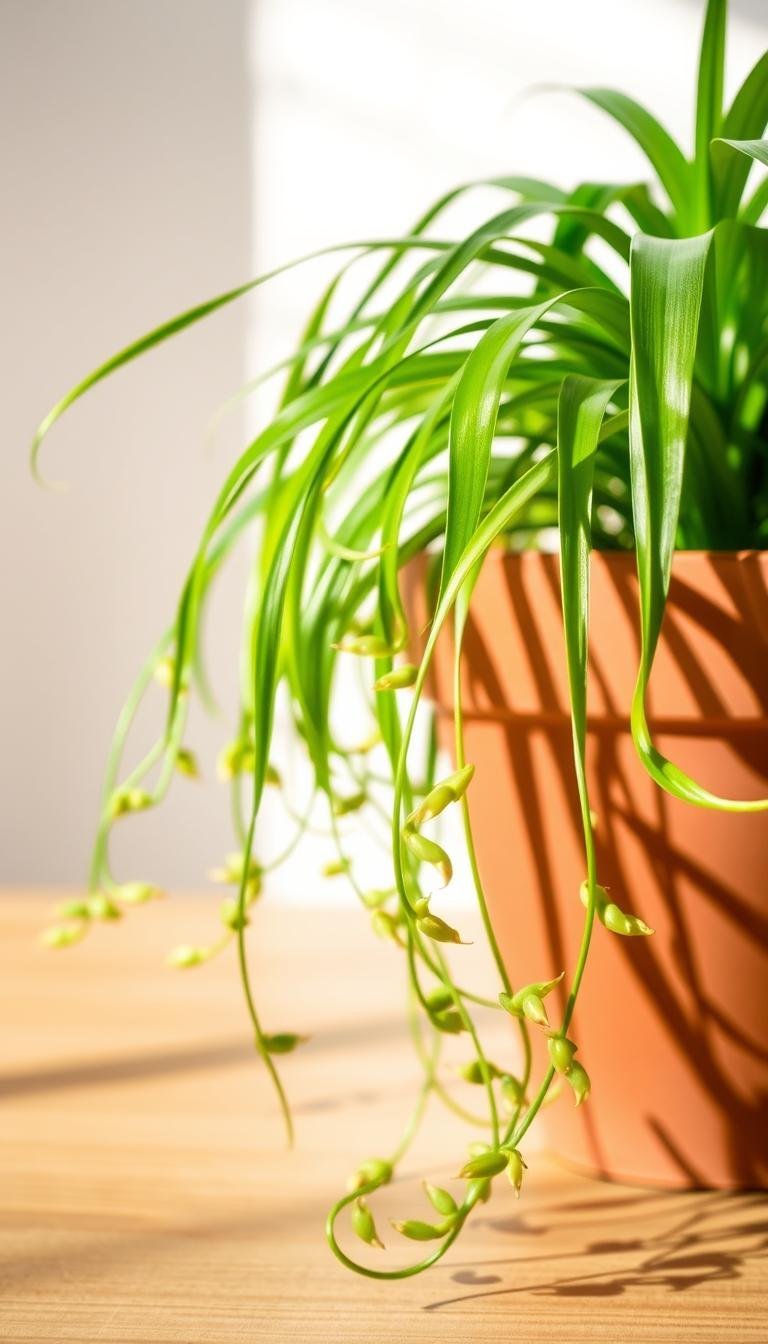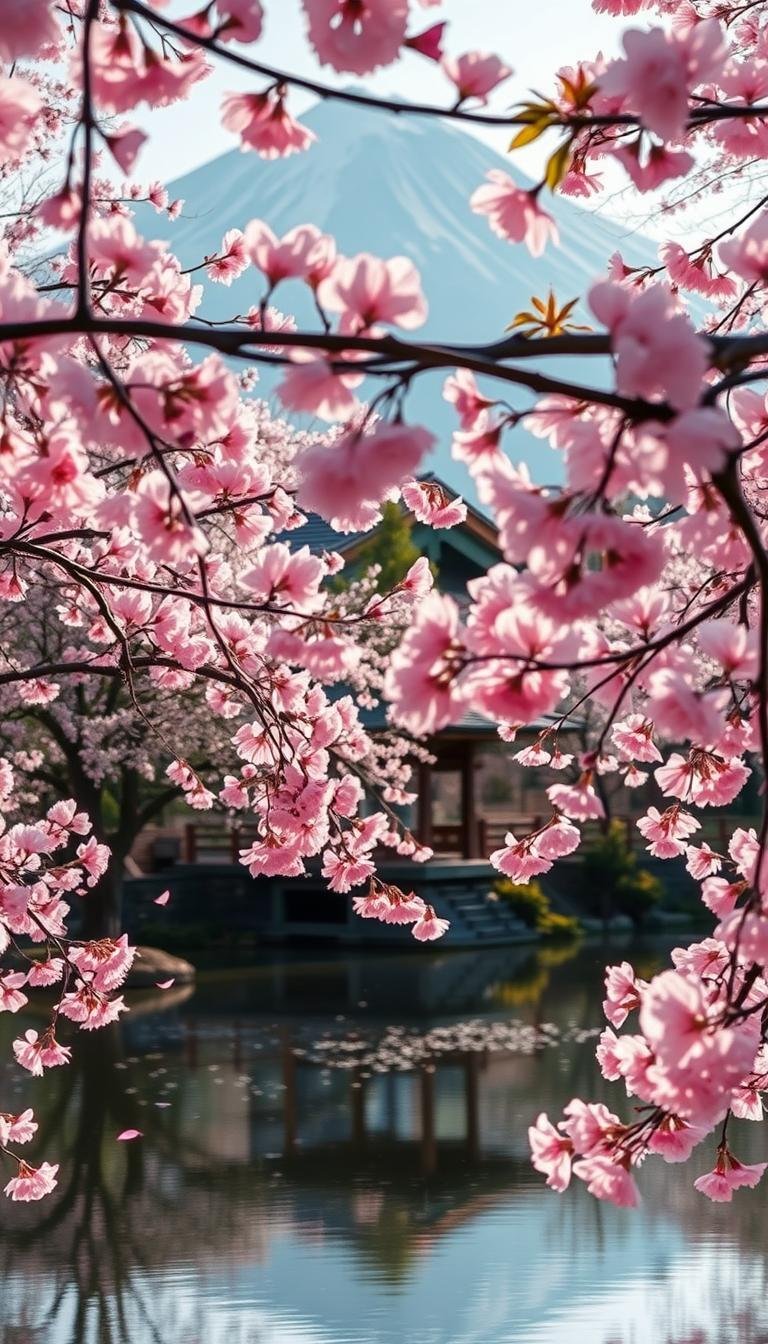This post may contain affiliate links. If you click and buy, we may earn a small commission at no extra cost to you. Learn more.
Japanese Flowers are more than just plants. They are symbols of nature’s artistry and Japan’s rich heritage. From delicate cherry blossoms to vibrant chrysanthemums, these blooms shape culture, inspire art, and connect people to seasons and traditions.
Cherry Blossoms, or sakura, capture global attention each spring. Their fleeting beauty represents life’s transience, a concept cherished in Japanese philosophy. These blossoms light up parks like Ueno in Tokyo, drawing crowds for hanami picnics under their pink canopies.
Discover how these flowers weave through festivals, gardens, and everyday moments. This article explores their history, symbolism, and how they thrive beyond Japan’s borders—in U.S. gardens and modern designs. Let’s celebrate their timeless charm together!
Contents
- 1 The Significance of Flowers in Japanese Culture
- 2 Popular Japanese Flowers and Their Characteristics
- 3 Seasonal Blooms: A Year-Round Floral Calendar
- 4 The Art of Ikebana: Japanese Flower Arranging
- 5 Festivals Celebrating Japanese Flowers
- 6 Growing Japanese Flowers in the U.S.
- 7 Japanese Flowers in Landscaping
- 8 The Role of Flowers in Japanese Cuisine
- 9 Floral Crafts: Traditional and Contemporary
- 10 Conclusion: Embracing the Beauty of Japanese Flowers
The Significance of Flowers in Japanese Culture
Flowers have been key in Japanese life for over a thousand years. They show the beauty ofwabi-sabi, finding beauty in imperfection and short life. This view makes flowers symbols of being present and connected to nature.
Historical Importance
Flowers were used in Shinto rituals to honor gods. In the Heian era, nobles used them in poetry. By the Edo period, looking at flowers together became a common activity. Today, cherry blossom festivals keep this tradition alive, celebrating the beauty of change.
Symbolism of Flowers
Each flower has its own meaning: chrysanthemums stand for royal power, and plum blossoms for strength. Iris flowers were a sign of bravery for samurai, and peonies meant honor in tea ceremonies. These meanings are seen in today’s weddings and greetings, where flowers speak without words.
Use in Traditional Arts
Ikebana, the art of flower arrangement, showswabi-sabi through its use of empty space. Ukiyo-e prints and haiku poems also celebrate the short life of flowers. They compare life’s brief time to the fleeting beauty of cherry blossoms.
Flowers connect art and philosophy, making every petal a reflection on life. From Zen gardens to kaiseki meals, flowers link fleeting beauty to lasting cultural wisdom.
Popular Japanese Flowers and Their Characteristics
Japan is known for its beautiful flowers that carry deep meanings. Let’s look at four famous flowers, each with its own special traits and traditions.

Cherry Blossoms (Sakura)
Cherry blossoms, or Sakura, represent new beginnings and beauty that doesn’t last. Types like Somei Yoshino and Kwanzan bloom in pink or white every year, welcoming spring. These trees love full sun and well-drained soil.
In Japan, Sakura trees are the heart of hanami picnics. People gather under the trees to enjoy life’s short moments.
Chrysanthemums (Kiku)
Kiku, or golden chrysanthemums, are very special in Japan. They are the symbol of the monarchy. Varieties like Ichimonji and Shugetsukai have beautiful petals.
These flowers need cool summers and some shade. Kiku festivals show off amazing flower arrangements, some taking months to make.
- Botanical note: Kiku can bloom in fall if grown in USDA zones 5–9.
- Cultural tip: Stems symbolize longevity when used in tea ceremonies.
Irises (Ayame)
Elegant irises, or Ayame, add color to ponds and gardens. Types like Kakitsubata love moist soil. They make water gardens look stunning.
Their leaves and flowers are often seen in ukiyo-e art. They stand for courage and faithfulness.
Peonies (Botan)
Peonies, or Botan, bloom in late spring. Their big flowers mean honor and wealth. Varieties like Kakizakura and Beni-Shide do well in rich soil and some shade.
In Japan, dried Botan petals are used in teas and desserts. They show the flower’s role in food.
These flowers are loved for their beauty and meaning. Next, we’ll see how their blooms shape Japan’s seasons.
Seasonal Blooms: A Year-Round Floral Calendar
Japan’s seasons change with each new flower. Cherry blossoms and winter camellias mark the year. These flowers guide traditions and inspire art.
“The year’s heartbeat is the rustle of petals unfurling,” say local gardeners who track each season’s arrival through blooms.
Spring: The Cherry Bloss Season
Spring is all about sakura’s pink clouds. But ume (plum blossoms) and botan (peonies) add more colors. Hanami picnics move as each flower blooms, making spring a colorful parade.
Summer: Vibrant Hydrangeas
Hydrangeas are summer’s stars, soaking up rain. Okayama’s Hydrangea Matsuri celebrates their colors. Sunflowers and kirakira (glittering) cosmos add to the summer show.
Fall: A Burst of Color
Fall ends with kiku (chrysanthemums) and maple leaves. Adachi Museum shows off layered displays. Chrysanthemums are shaped for Kiku Matsuri, even as it gets cold.
Camellia Japonica, or tsubaki, blooms in winter. Its glossy red and white flowers stand out in snow. It thrives in USDA zones 7-9, perfect for the American Southeast or Pacific Northwest.

These cycles are seen in America too. Pacific Northwest winters see Camellia Japonica blooms, just like Kyoto. Each season’s flowers connect cultures through nature’s rhythm.
The Art of Ikebana: Japanese Flower Arranging
Ikebana turns flowers into silent talks between us and nature. This ancient art, over 600 years old, mixes discipline with creativity. It’s in every stem and leaf.

Principles of Ikebana
Ikebana teaches us to respect life’s short beauty. It has three main rules: shu (truth), gyō (form), and jō (freedom). It balances empty space with living things, like nature does. Even a single branch can tell a story of growth and decay.
Different Styles of Ikebana
- Ikenobo: The oldest school using geometric lines and symbolic placements.
- Sogetsu: Modernists here use unconventional items like metal or stones.
- Ohara: Focuses on natural landscapes in miniature, often with moss-covered branches.
Ikebana in Modern Japan
Today, over 2,000 schools teach Ikebana in schools and community centers. Tokyo’s annual exhibition draws thousands, showing arrangements from cherry blossoms to autumn maples. Beginners can start with three easy steps:
- Choose a low container and sharp shears
- Place one tall branch as the “heaven” element
- Add secondary stems at 45-degree angles
Try using seasonal blooms like hydrangeas or pine for instant connection to Japan’s floral heritage. Even a small arrangement becomes a daily meditation on nature’s cycles.
Festivals Celebrating Japanese Flowers
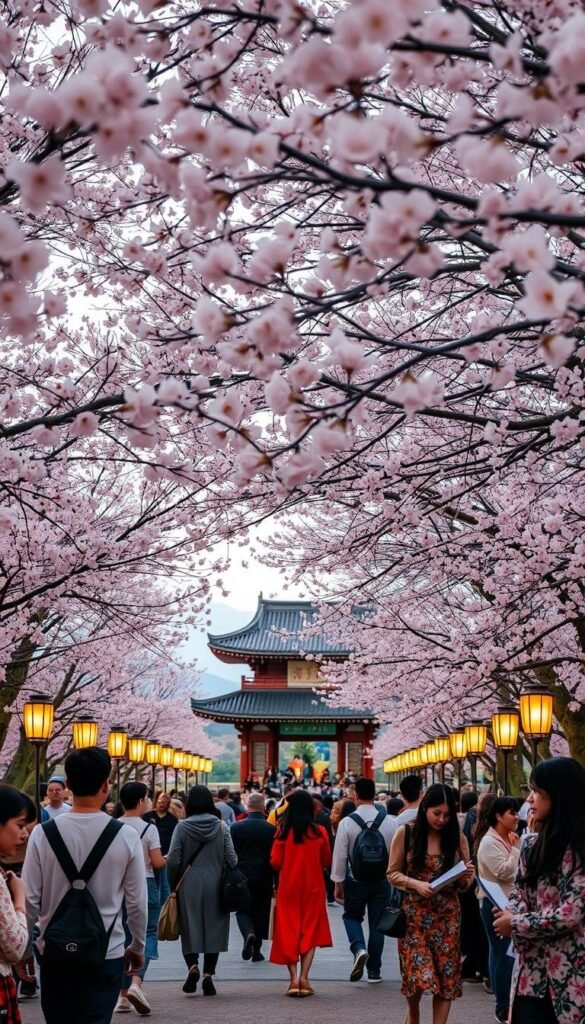
Japan’s floral festivals turn blooming seasons into joyful gatherings. These events blend tradition with modern community spirit. They invite everyone to celebrate life’s fleeting beauty.
Hanami: The Cherry Blossom Festival
Hanami festivals come alive as sakura petals paint the sky pink. People spread blankets under blossoms for picnics. At night, yo zakura (night blooms) light up parks with soft lanterns.
In Washington, D.C., the National Cherry Blossom Festival draws millions each spring. Key highlights include:
- Live taiko drumming and dance performances
- Picnic kits featuring bento boxes and sake
- Guided hanami walking tours
Kiku Matsuri: The Chrysanthemum Festival
Fall’s kiku (chrysanthemum) shows transform gardens into art galleries. Delicate petals form shapes, with competitions judging years of cultivation. Tokyo’s Adachi Museum hosts displays with thousands of blooms arranged in geometric patterns.
Ongaku Matsuri: Music and Flowers
Flower festivals bloom with melody. Traditional instruments like the koto and shakuhachi fill the air. Dancers weave through crowds.
In Portland, Oregon’s Japanese Garden hosts koto concerts during autumn chrysanthemum exhibits. They blend sound and sight.
Growing Japanese Flowers in the U.S.
It’s easy to bring the beauty of Japanese Flowers to your garden in America. Many types grow well across the country with the right care. Let’s dive into how you can create your own Japanese garden.
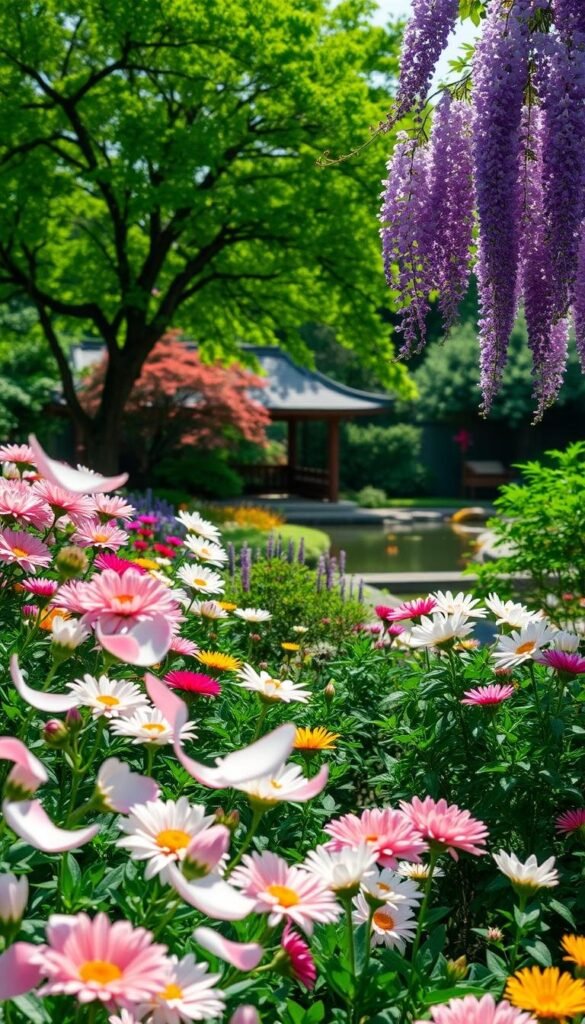
Climate Considerations
USDA zones 5–9 are perfect for many Japanese Flowers. Remember, humidity matters. Chrysanthemums do well in dry areas, while hydrangeas like moist soil. Mulch helps protect roots in cold weather.
Best Practices for Home Gardens
- Make sure the soil pH is right for each flower; most like slightly acidic.
- Plant them far enough apart based on their root depth to avoid stress.
- Water them deeply but don’t get the blooms wet to stop mildew.
“After adjusting my soil pH, my wisteria blooms twice a year!” – Linda, a gardener in Oregon
Recommended Varieties for North America
- Botan (Peonies): Hardy in zones 3–8, they love full sun.
- Ayame (Japanese Iris): Prefers wet soil and blooms in late spring.
- Sakura Cherry Blossoms: Pick cold-hardy types like Yoshino for spring blooms.
Follow these tips to enjoy Japanese Flowers all year. Begin small and let their beauty transform your outdoor space!
Japanese Flowers in Landscaping

Japanese floral traditions turn outdoor spaces into peaceful retreats. These principles can make any landscape, big or small, feel serene.
Garden Designs Featuring Japanese Flora
Styles like stroll gardens, tea gardens, and zen rock gardens use flowers to guide and reflect. Cherry blossoms line paths in stroll gardens. Moss and chrysanthemums frame tea ceremony spaces.
Even small spaces can have these designs. Use containers or raised beds to mimic them.
Incorporating Seasonal Textures and Colors
- Spring: Cherry blossoms (sakura) and wisteria for soft pinks and purples
- Fall: Maples and late-blooming asters add fiery reds and oranges
- Winter: Evergreen hollies and winter jasmine contrast with snow
Cultural Themes and Inspirations
Shinrin-yoku, or forest bathing, influences modern designs. Gardens become healing spaces with open lawns and winding paths. Water features add to the tranquility.
Public gardens like Portland Japanese Garden and Longwood Gardens show these ideas. For your home, pair irises or peonies with gravel and stone lanterns. This creates a peaceful atmosphere.
Begin with a small corner. Add bamboo accents and dwarf azaleas. Visit Japanese cultural centers or botanical gardens for inspiration. Every detail, from pruned pines to seasonal blooms, connects us to nature’s rhythms. It invites mindfulness into our daily lives.
The Role of Flowers in Japanese Cuisine
Japanese Flowers add delicate flavors and carry seasonal meanings. Their petals, leaves, and roots are used in cooking. This connects diners to nature and art.
“A plate without flowers is like a poem without imagery.” — Traditional Japanese culinary philosophy
Edible Flowers: A Culinary Delight
These blooms enhance dishes from start to finish:
- Sakura (cherry blossoms): Marinate in salt for sakura mochi, sweet rice cakes wrapped in preserved leaves.
- Kiku (chrysanthemums): Steep petals in hot water for tea or sprinkle minced blooms over salads.
- Botan (peonies): Thinly sliced petals garnish sashimi or infuse vinegars for dipping sauces.
Presentation and Aesthetics
Floral arrangements like ikura no hana-zuke (flower-marinated salmon) reflect the seasons. They offer a feast for the eyes and taste buds. Even home cooks can add petals to soups or desserts for a touch of elegance.
Seasonal Ingredients and Festivities
Spring’s sakura inspire pink-tinted sweets, while autumn’s chrysanthemums are in kiku-zake hot pot. Celebrate by making sakura-mizu (blossom-infused syrup) for cakes or pancakes.
Floral Crafts: Traditional and Contemporary
Turn Japanese flowers into lasting art with old and new methods. Flower pressing keeps petals’ beauty for creative projects. You can use heavy books or modern tools like microwave presses to speed up the process.
Camellia Japonica, with its shiny leaves and bright petals, is perfect for this. Here’s a simple project to try at home:
- Choose fresh Camellia Japonica flowers, picking those with firm petals.
- Layer between sheets of parchment paper.
- Place between pages of a thick book; add weight on top.
- Wait 2-3 weeks, then use preserved flowers for crafts.
Pressed flowers are great for home decor. Frame them for wall art or glue them onto note cards. Seasonal wreaths with dried Camellia Japonica petals brighten doorways. Mix blooms with bamboo or silk ribbons for a touch of Japan in any space.
Sustainable fashion trends love botanical beauty. Camellia Japonica petals mixed with natural dyes make eco-friendly textiles. Designers use flower pigments to fabrics, cutting down on chemicals.
Botanical prints on kimonos or scarves show Japan’s floral heritage. They also care for the environment.
Conclusion: Embracing the Beauty of Japanese Flowers
Japanese flowers are more than just pretty—they connect us to nature and tradition. From cherry blossoms to chrysanthemums, they carry deep meanings and philosophies. By embracing wabi-sabi, we find joy in the fleeting beauty of life.
This way of thinking changes how we see the world. It teaches us to appreciate the present moment.
Personal Connection to Nature
Getting involved with Japanese flowers helps us be more mindful. Watching cherry blossoms fade reminds us of life’s shortness. It teaches us to cherish the now.
Whether we have a small garden or visit a park for hanami, these moments are precious. Even a simple potted peony can inspire daily reflection.
Sharing Japanese Floral Culture
Floral festivals like hanami are now enjoyed worldwide. Cities like Washington D.C. and Brooklyn host these events, mixing global joy with local traditions. Museums and gardens show off ikebana, making these traditions available to all.
Sharing photos of seasonal blooms online connects people everywhere. It spreads the joy of these traditions across continents.
A Call to Explore and Appreciate
You don’t need to travel to discover Japanese flowers. You can attend a local festival, grow hydrangeas, or try ikebana. Visit botanical gardens for seasonal displays or bake with edible petals.
Every small action strengthens our connection to nature and culture. The beauty of these traditions is in their flexibility. They can be enjoyed formally or casually, making our daily lives richer.
To bring you cozy inspiration more efficiently, we sometimes use AI to assist in content creation — but every word and idea is carefully shaped by our team. See our AI Disclosure for more info.


